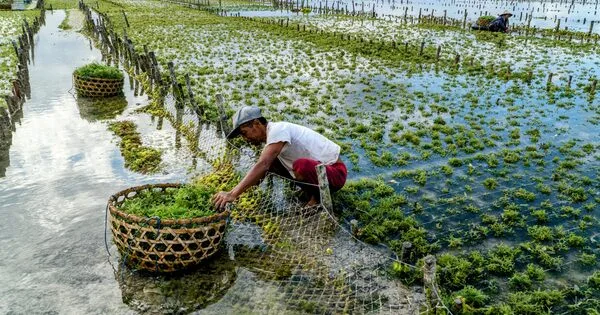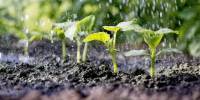Seaweed farming, often known as kelp farming, is the cultivation and harvesting of seaweed. Seaweed cultivation is used for a variety of purposes, including food, medicines, biofuels, and other industrial applications. Farmers can gather from natural beds in their most basic form, or they can completely regulate the crop’s life cycle. Seaweed farming has become popular due to its potential environmental and economic benefits.
The seven most farmed taxa are Eucheuma spp., Kappaphycus alvarezii, Gracilaria spp., Saccharina japonica, Undaria pinnatifida, Pyropia spp., and Sargassum fusiforme. Eucheuma and K. alvarezii are desirable for carrageenan (a gelling agent); Gracilaria is grown for agar; and the remainder are consumed after minimal processing. Seaweeds, unlike mangroves and seagrasses, are photosynthetic algal organisms that do not blossom.
Here are some key aspects of seaweed farming:
(1) Types of Seaweed Cultivated:
- Red, Green, and Brown Seaweeds: These are the three main categories of seaweed, each with its own unique characteristics and uses.
- Popular Species: Some commonly cultivated seaweed species include kelp, nori, dulse, wakame, and kombu.
(2) Cultivation Methods:
- Long Lines or Ropes: Seaweed can be grown on long lines or ropes that are suspended in the water. This method is commonly used for kelp farming.
- Raft Cultivation: Floating rafts or platforms can be used to support seaweed cultivation, allowing for easy harvesting.
- Seabed Cultivation: Some types of seaweed can be cultivated directly on the seabed using mesh structures.
(3) Environmental Benefits:
- Carbon Sequestration: Seaweed absorbs carbon dioxide during photosynthesis, helping to mitigate climate change by sequestering carbon.
- Nutrient Remediation: Seaweed farming can help improve water quality by absorbing excess nutrients, reducing the risk of harmful algal blooms.
(4) Economic Uses:
- Food: Seaweed is a nutritious food source, rich in vitamins, minerals, and proteins. It is used in various cuisines around the world.
- Pharmaceuticals: Some seaweeds contain bioactive compounds with potential medicinal properties.
- Biofuels: Seaweed can be used for the production of biofuels such as bioethanol and biodiesel.
(5) Challenges:
- Environmental Impact: While seaweed farming can have positive environmental effects, it’s important to manage potential negative impacts, such as shading marine ecosystems and interactions with local biodiversity.
- Harvesting and Processing: Developing efficient and sustainable harvesting and processing methods is crucial for the success of seaweed farming.
As of 2022, the largest seaweed-producing countries are China (58.62%) and Indonesia (28.6%), followed by South Korea (5.09%) and the Philippines (4.19%). Other significant producers are North Korea (1.6%), Japan (1.15%), Malaysia (0.53%), Zanzibar (Tanzania, 0.5%), and Chile (0.3%). Seaweed farming has regularly been established to boost economic conditions and alleviate fishing pressure.
Seaweed farming is a constantly evolving sector, with continual research and development to handle difficulties and optimize potential benefits. It helps to ensure sustainable food production, protect the environment, and produce innovative bio-based goods.
















